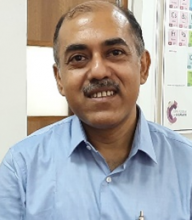
Ph.D., 2002, IIT Kanpur
Synthetic Chemistry: Organic Synthetic Radical Chemistry; Sustainable Synthetic Spin Chemistry; Synthesis of New Generation of Organometallic Compounds; Electron Transfer Reactions; Synthesis of New Electro-active Functional Materials
Molecular Materials: Organic Ferroelectrics; Organic Multi-Electron Reservoirs; Organic Conductive Materials; Organic Magnetism; Organic Electronics; Multi-channel Radical Ion Probes; Organic Nonlinear Optically Active Materials; Singlet Fission
Supramolecular Chemistry: Design of Electro-active Macrocyclic Hosts; Engineering of Soft and Nano-materials
Computational Chemistry: Studies of different types of non-bonded interactions by DFT, NBO and AIM calculation methods; Opto-electronic property calculations; Prediction of spin density, diradicaloid and singlet-triplet energy; Aromaticity
Professor, SPS, JNU, New Delhi
Invited Professor, Faculty of Chemistry, Institut Le Bel, University of Strasbourg, France
JSPS Research Fellow, Kyushu University, Japan
Faculty Research Assistant, University of Maryland, College Park, USA
DST-DAAD Exchange Research Fellow at University of Saarlandes, Germany
- CRSI Bronze Medal
- DST-SwarnaJayanti Fellow
- Associate Member of the Indian Academy of Sciences, Bangalore
- JSPS Research Fellow
- DST-DAAD Research Fellow
- ISCA Young Scientist Award
Invited Professor, Faculty of Chemistry, University of Strasbourg
Invited Professor, Department of Chemistry, Graduate School of Science, Osaka Metropolitan University, Japan
Research Summary:
Our group’s research interests involve various aspects of design, synthesis and stabilization of organic radicals and radical ions. One of the major achievements of our group has been to stabilize various types of organic radicals, e.g., radical anions, radical cations and zwitterionic radicals through intramolecular non-covalent interactions. The isolated organic radicals have been designed to be ambient stable and, in a few cases, even stable to chromatography.
The group’s other areas of interest include synthesis of organic multi-electron redox active systems. Research in this area has led to the isolation of some of the strongest electron acceptors and electron donors, including electron-sponges and electron-reservoirs.
In addition, the group is interested in the design and synthesis of organic molecular and supramolecular materials, e.g., organic near-infrared and mid-IR absorbers, panchromatic molecules, multi-channel radical-based sensors, organic semiconductors, organic ferroelectrics, organic piezoelectrics, and organic NLO-active materials. Along with these areas, the group has started working on the synthesis of organic redox-active drugs as well as hybrid drug molecules.
The research scholars in the group are trained in organic and organometallic synthesis, purification of complex systems, isolation and handling of reactive compounds. The scholars get trained in various spectroscopic, spectrometric and electrochemical techniques, as well as become proficient in growing of single crystals and single crystal X-ray crystallography. The students have access to AFM, PFM and Rheometer for studying novel supramolecular materials. The students also acquire skills in the basic and advanced aspects of computational studies.
Ongoing Projects and Major projects undertaken in the past:
1. Design, Synthesis and Supramolecular Integration of Spin Crossover Complexes with Stable Radical Ions: Towards Redox-, Color- and Magneto-SwitchabIe Materials. SERB (Completed).
2. Development of pi-conjugated supramolecular motifs as organic radical precursors ….organic electronics and multifunctional biomedical imaging. DST-WOS (2021-2023, as a Mentor).
3. Exploring design, synthetic and computational tools…..and their self-assembled soft materials. DST, Govt. of India (2015-2020).
4. Design and Synthesis of Naphthalenediimide-based Organic Radical Ions and their Tuned Metal Complexes for Magnetic Studies. SERB (2017-2019, as Mentor of NPDF)
-
A Folded p-system with Supramolecularly Oriented Dipoles: Single-Component Piezoelectric Relaxor with NLO Activity. S. De, D. Asthana, C. Thirmal, S. K. Keshri, R. K. Ghosh, G. Hundal, R. Kumar, S. Singh, R. Chatterjee, P. Mukhopadhyay*
Chem. Sci., 2023, 14, 2547-2552. -
A Highly Contorted Push-Pull Naphthalenediimide Dimer and Evidence of Intramolecular Singlet Exciton Fission. D. Bansal, A. Kundu, V. P. Singh, A. K. Pal, A. Datta*, J. Dasgupta*, P. Mukhopadhyay*
Chem. Sci. 2022, 13, 11506. (Cover Article) -
Naphthalenediimides with High Fluorescence Quantum Yield: Bright-Red, Stable and Responsive Fluorescent Dyes. S. K. Keshri, K. Mandal, Y. Kumar, D. Yadav, P. Mukhopadhyay*
Chem. Eur. J. 2021, 27, 6954-6962. -
Synthesis of Stable, High-SOMO Zwitterionic Radicals: Enabling Electron Transfer Between Naphthalenediimides. J. Shukla, S. Kumar, Rustam, P. Mukhopadhyay*
Org. Lett. 2020, 22, 6229-6233. (Cover Article) -
Doubly-Zwitterionic, Di-reduced, Highly Electron-Rich, Air-Stable Naphthalenediimides: Redox-Switchable Islands of Aromatic-Antiaromatic States. Kumar, S., Shukla, J., Mandal, K., Kumar, Y., Prakash, R., Ram, P., Mukhopadhyay, P.*
Chem. Sci. 2019, 10, 6482-6493. -
Isolation of Tetracyano‐Naphthalenediimide and Its Stable Planar Radical Anion
Y. Kumar, S. Kumar, K. Mandal, P. Mukhopadhyay*
Angew. Chem. Int. Ed. 2018, 57, 16318-16322 (Hot Paper) -
Extraordinary stability of naphthalenediimide radical ion and its ultra-electron-deficient precursor: strategic role of the phosphonium group.
P. Mukhopadhyay, et al. J. Am. Chem. Soc. 2014, 136, 12004-12010.
- Synthesis of Phosphinylated Naphthalene Diimides and Radical Anions: A SeT-Mediated Route Circumvents the Use of Metal/ Photocatalyst, R. Tamim, P. Saini, Krishna K. MS, Y. Kumar, Pritam Mukhopadhyay*
J. Org. Chem. 2025, ASAP. Front Cover. https://doi.org/10.1021/acs.joc.4c02501 - Water‐Stable, Eight‐electron Acceptor Drives Anion∙∙∙Water Assisted Tunable Ionic Self‐Assembly and Proton Conduction. J. Shukla, S. P. Bera, M. R. Ajayakumar, S. Konar, P. Mukhopadhyay
Chem. Eur. J. 2024, e202401334 - Unravelling the Intramolecular n→σ* Interaction in Ultra-Electron Deficient Naphthalenediimides and their Radical Ions. K. Mandal, M. R. Ajayakumar, G. Hundal, P. Mukhopadhyay
Phys. Chem. Chem. Phys. 2024, 26, 26076-26083. - Oxidative Organic Transformations Photocatalyzed by NDI in Visible Light A. Datta, Ritu, S. Kumar, S. Chorol, P. Mukhopadhyay, N Jain
Org. Lett. 2024, 26, 7357-7362. - Synthesis, Stability, Meisenheimer Complex Formation, and Charge‐Transfer Properties of Ultra‐Electron‐Deficient Tetracyano‐Naphthalene Diimides D. Yadav, Y. Kumar, C. M. Husain, K. Mahiya, P Mukhopadhyay*
Eur. J. Org. Chem. 2024, 27, e202400412. - Naphthalene diimide–Annulated Heterocyclic Acenes: Synthesis, Electrochemical and Semiconductor Properties and Their Multifaceted Applications A. Bhardwaj, C. Mudasar Hussain, P. Dewangan, P. Mukhopadhyay*
Chem. Eur. J., 2024, e202400208.
- Method of screening anti-plasmodial activity of acriflavin and acriflavin as an anti-malarial agent, S. K. Dhar, S. Dana, A. Dar, D. Prusty, P. Mukhopadhyay, US Patent 9,375,426.
- Fibrous fullerene, fibrous fullerene polymer, and their manufacture by using sublimable solvent, N. Fujita, S. Malik, P. Mukhopadhyay, S. Shinkai, Jpn. Kokai Tokkyo Koho (2008), JP 2008150249 A 20080703.